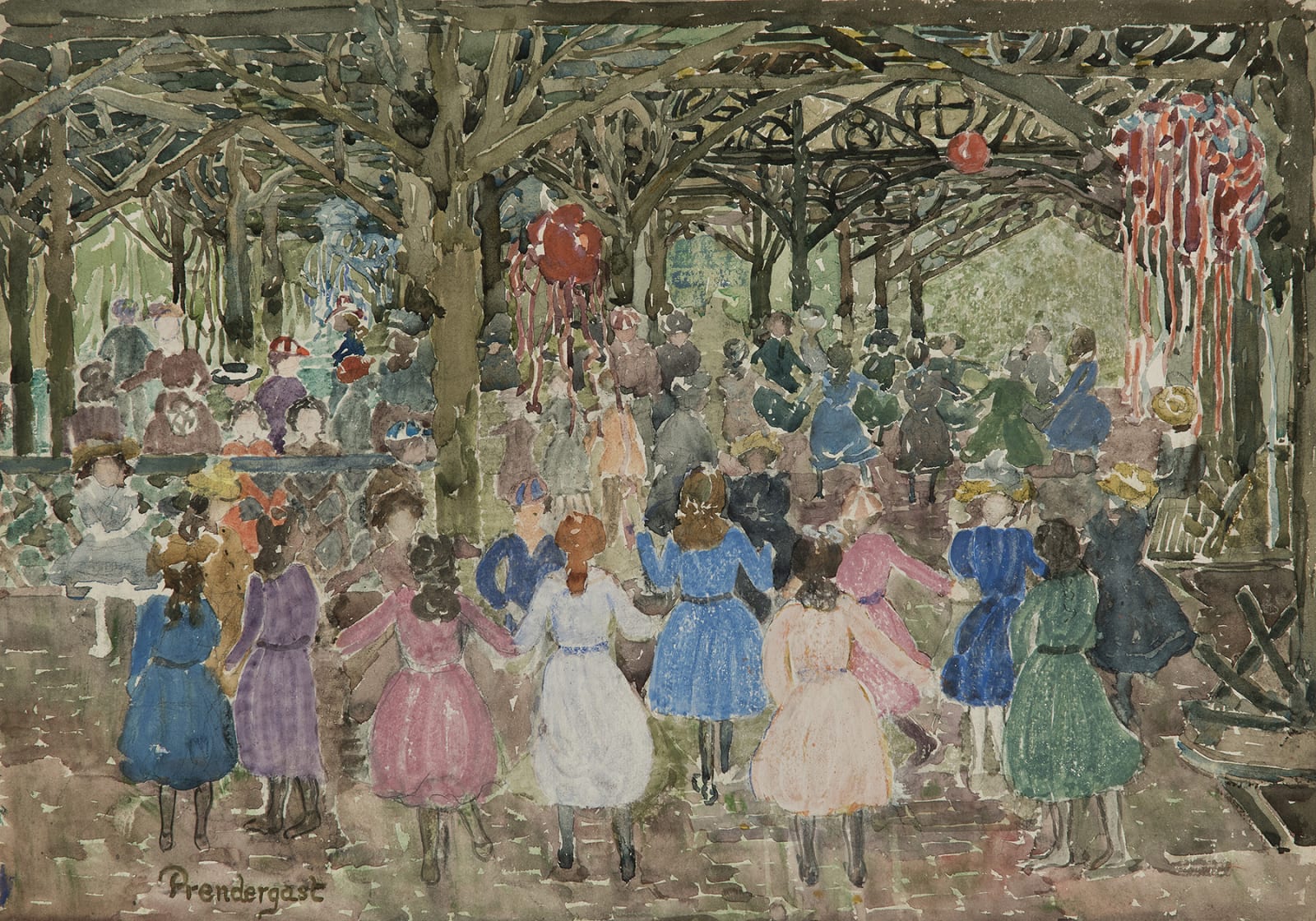Maurice Prendergast American, 1858-1924
Central Park, c. 1900-1903
Watercolor, pencil and gouache on paper
13 3/4 x 19 3/4 inches
34.9 x 50.2 cm
34.9 x 50.2 cm
Signed at lower left: Prendergast
The scene likely depicts a since-demolished pavilion in Central Park called the Kinderberg Summerhouse. According to the Central Park Conservancy, Soon after the Park was opened in the 1860s, it...
The scene likely depicts a since-demolished pavilion in Central Park called the Kinderberg Summerhouse. According to the Central Park Conservancy,
Soon after the Park was opened in the 1860s, it was criticized by local newspapers for its lack of facilities for children and their caregivers. The commissioners responded by creating a Children's District in the southern part of the park. The features included the Dairy, the playground (now Heckscher Playground and Ballfield), a children's cottage (since demolished), and the Kinderberg, or "children's mountain," where the Park's largest rustic shelter once stood. In 1952, private funds enabled construction of the Chess & Checkers House to replace the Kinderberg [www.centralparknyc.org].
The Kinderberg Summerhouse was built in 1866 in a style similar to that of Belvedere Summerhouse: "rustic" joinery of unmilled timber. The Kinderberg was larger--the largest open-structure in the park--and its environs were designated for use by only children and their caregivers. The Central Park Conservancy remarks that the structure was destroyed by the 1950s, and while contemporaneous reporting by The New York Times suggests "the old rustic wooden structure was destroyed by fire" by 1951 [The New York Times, Dec. 10, 1951]. The following year, a brick structure was raised in its place, and continues to stand as the Chess and Checkers House. In 1984, the Central Park Conservancy renovated the structure and added a wisteria pergola, a shading element that echoes the form of the original children's hill pavilion.
While the present work has been exhibited under the title Nantasket Pier, the authors of the Prendergast catalogue raisonne published their view that the work "is probably from the series of park scenes” [C. Clark, N. Mathews, G. Owens, Maurice Brazil Prendergast, Charles Prendergast: A Catalogue Raisonné (1990), p. 412]. The limited records of the original pavilion support this view: the distinctive rough-hewn columns and rafters of the Kinderberg Summerhouse more closely resemble the current image than do contemporaneous views of the Nantasket Pier. Further, the gathering of exclusively children is in keeping more with the exclusivity of the children's zone than with a pier, which would have hosted a decidedly more mixed population. Finally, this conclusion is supported by Prendergast's ample output of Central Park scenes in the years of this work's creation.
Soon after the Park was opened in the 1860s, it was criticized by local newspapers for its lack of facilities for children and their caregivers. The commissioners responded by creating a Children's District in the southern part of the park. The features included the Dairy, the playground (now Heckscher Playground and Ballfield), a children's cottage (since demolished), and the Kinderberg, or "children's mountain," where the Park's largest rustic shelter once stood. In 1952, private funds enabled construction of the Chess & Checkers House to replace the Kinderberg [www.centralparknyc.org].
The Kinderberg Summerhouse was built in 1866 in a style similar to that of Belvedere Summerhouse: "rustic" joinery of unmilled timber. The Kinderberg was larger--the largest open-structure in the park--and its environs were designated for use by only children and their caregivers. The Central Park Conservancy remarks that the structure was destroyed by the 1950s, and while contemporaneous reporting by The New York Times suggests "the old rustic wooden structure was destroyed by fire" by 1951 [The New York Times, Dec. 10, 1951]. The following year, a brick structure was raised in its place, and continues to stand as the Chess and Checkers House. In 1984, the Central Park Conservancy renovated the structure and added a wisteria pergola, a shading element that echoes the form of the original children's hill pavilion.
While the present work has been exhibited under the title Nantasket Pier, the authors of the Prendergast catalogue raisonne published their view that the work "is probably from the series of park scenes” [C. Clark, N. Mathews, G. Owens, Maurice Brazil Prendergast, Charles Prendergast: A Catalogue Raisonné (1990), p. 412]. The limited records of the original pavilion support this view: the distinctive rough-hewn columns and rafters of the Kinderberg Summerhouse more closely resemble the current image than do contemporaneous views of the Nantasket Pier. Further, the gathering of exclusively children is in keeping more with the exclusivity of the children's zone than with a pier, which would have hosted a decidedly more mixed population. Finally, this conclusion is supported by Prendergast's ample output of Central Park scenes in the years of this work's creation.
Provenance
The artist; toCharles Prendergast (his brother), 1924; to
Mrs. Charles Prendergast, Westport, Connecticut (his wife), 1948;
[M. Knoedler & Co., New York, 1969]; to
Private collection, Tennessee, 1970; to
[Sale: Sotheby’s, New York, November 30, 1989, lot 170]; to
Private collection, Connecticut, until the present

